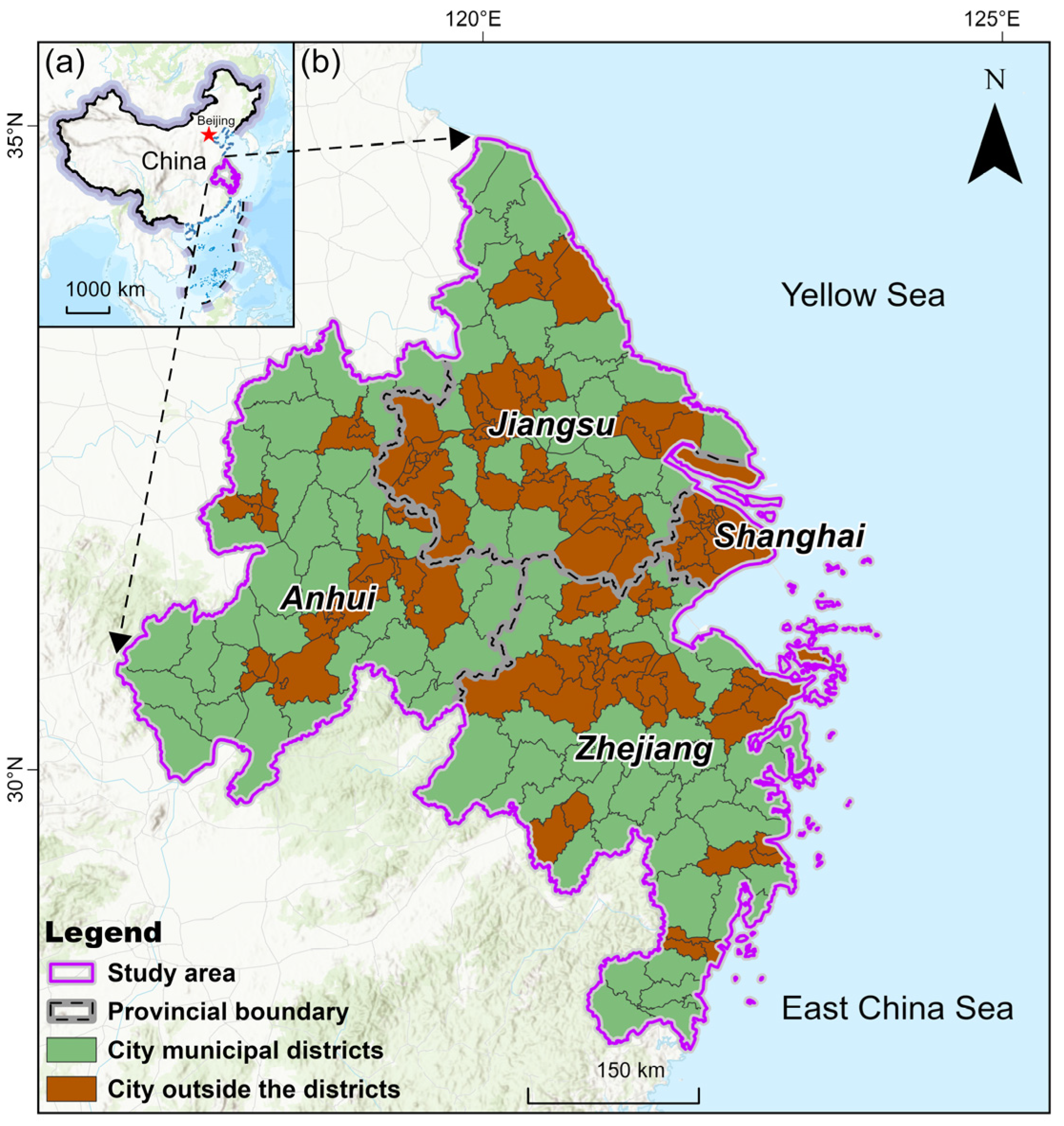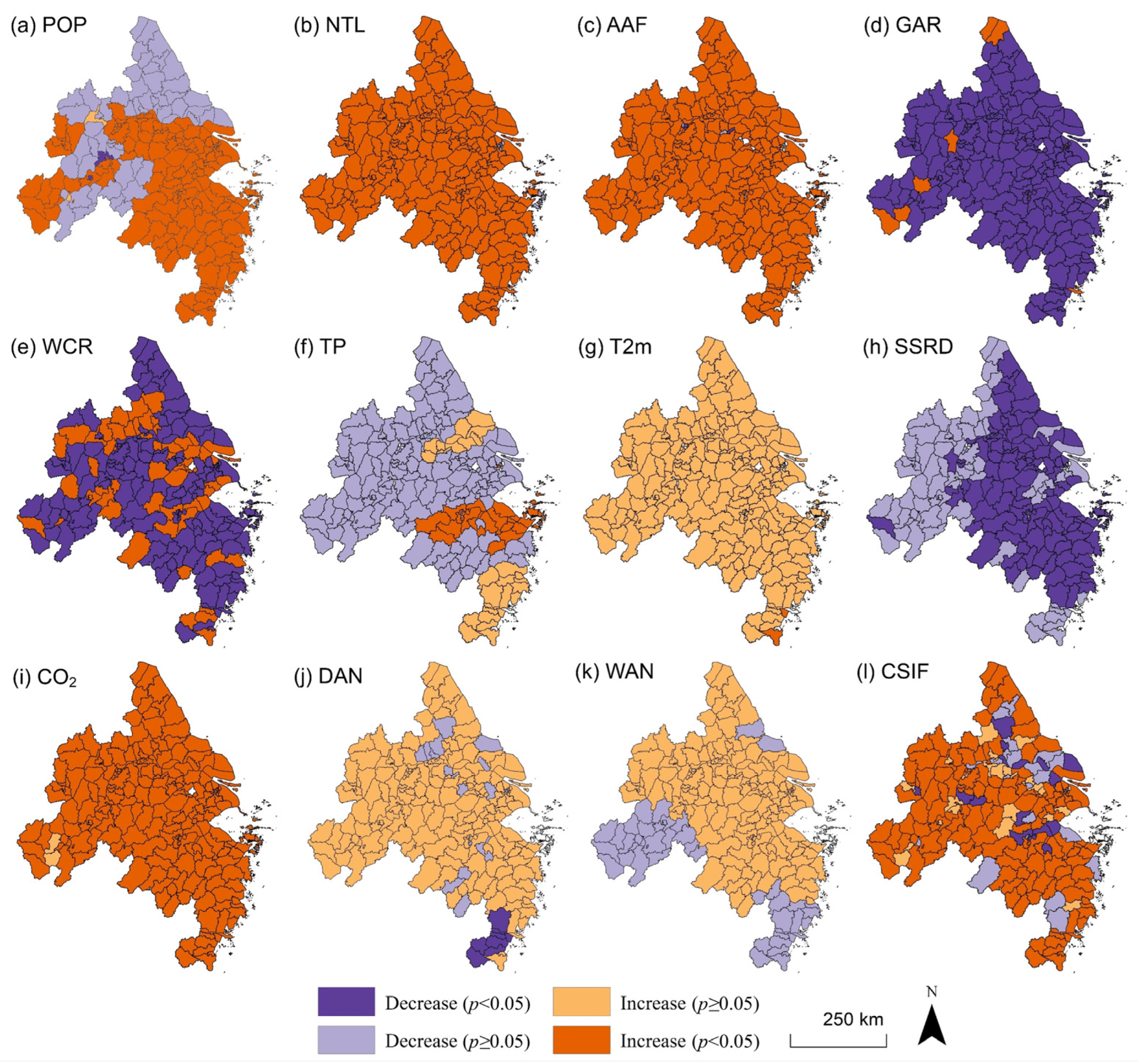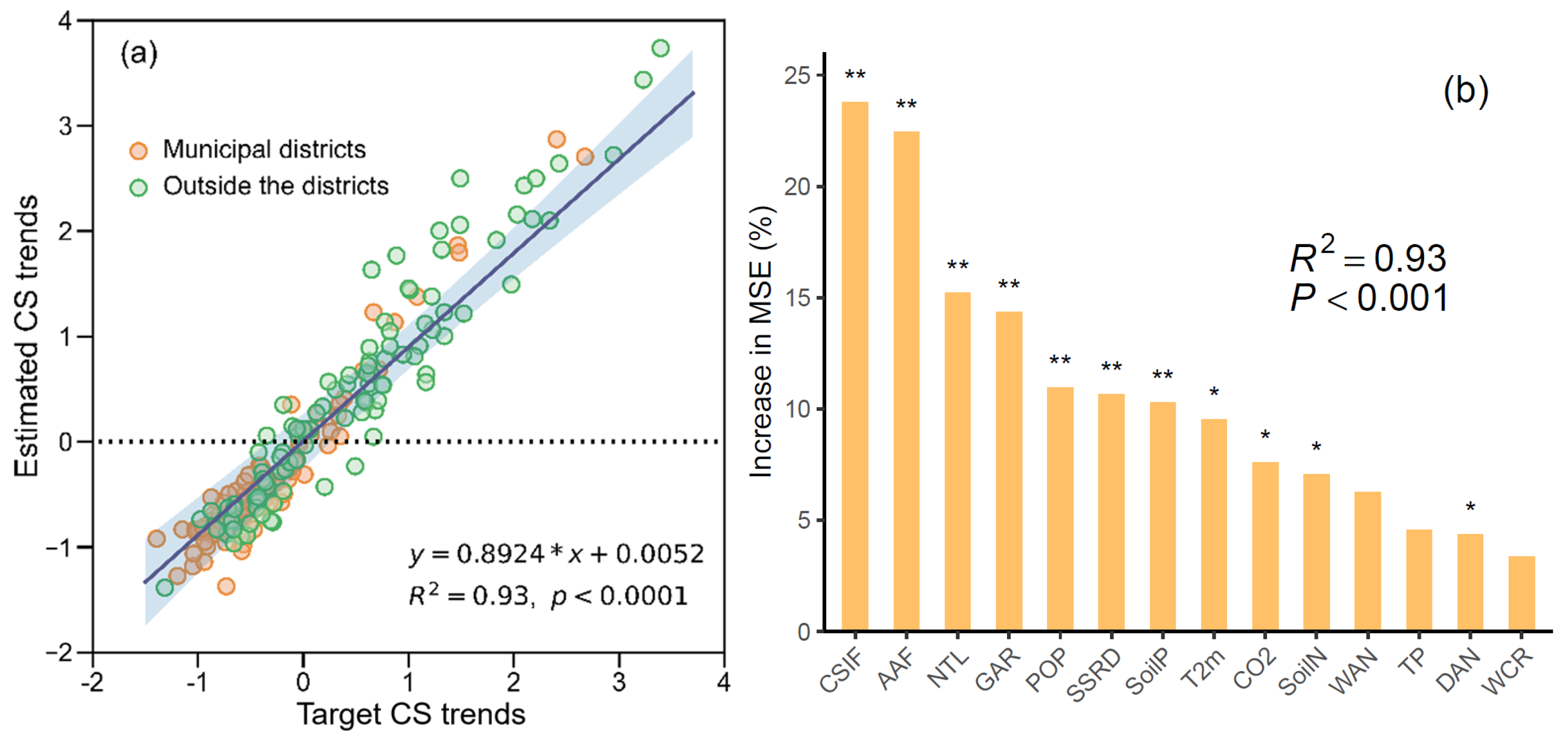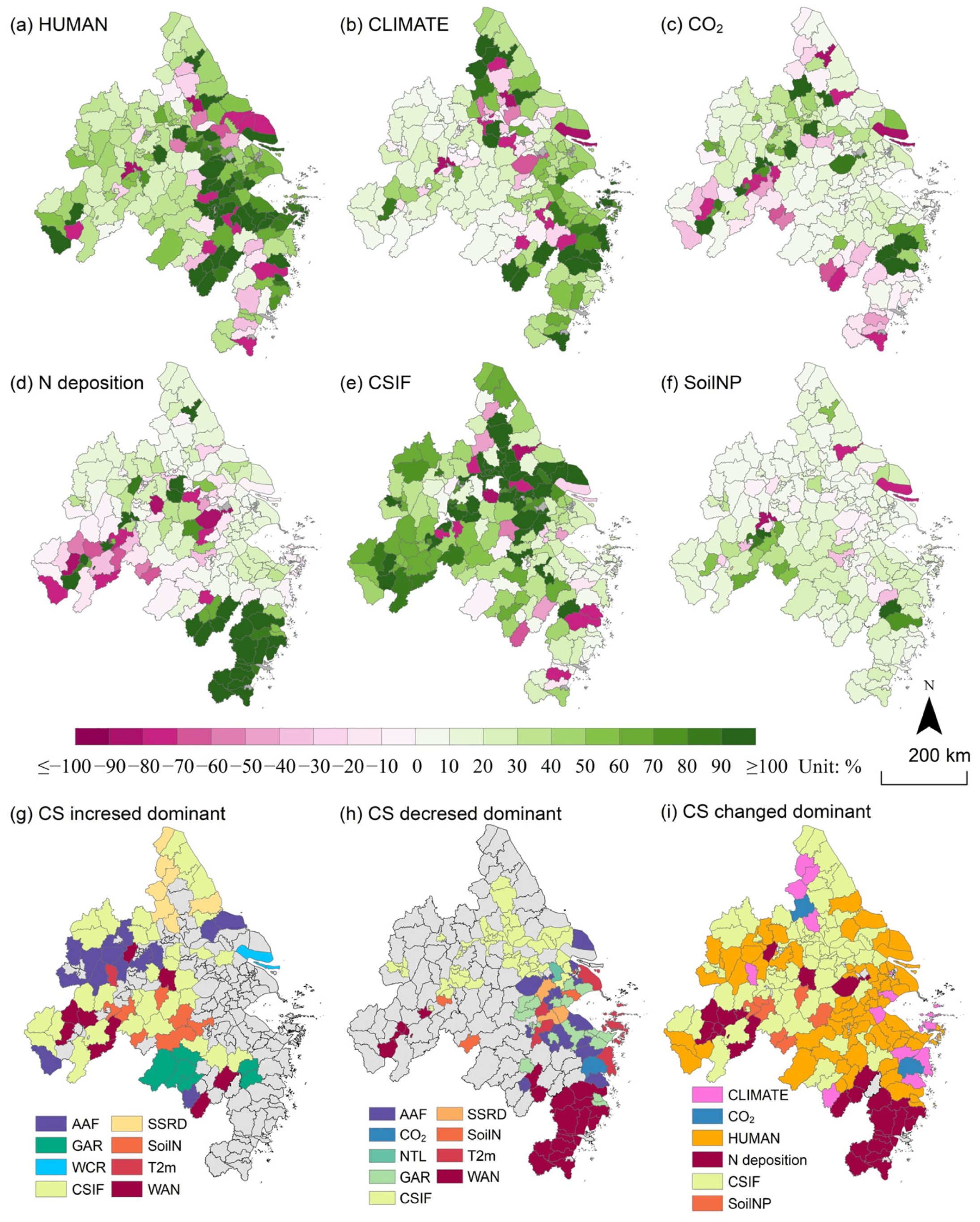Spatiotemporal Drivers of Urban Vegetation Carbon Sequestration in the Yangtze River Delta Urban Agglomeration: A Remote Sensing-Based GWR-RF-SEM Framework Analysis
Abstract
1. Introduction
2. Materials and Methods
2.1. Study Area
2.2. Data Sources
2.2.1. Carbon Sequestration Data
2.2.2. Carbon Sequestration Driving Factors
2.3. Methodology
2.3.1. Establishment of Urban Vegetation Carbon Sequestration Attribution Analysis Framework
2.3.2. Analysis of Carbon Sequestration Driving Contribution Using GWR-RF
2.3.3. Analysis of Carbon Sequestration Driving Causality Using SEM
3. Results
3.1. Spatial–Temporal Distribution of Carbon Sequestration and Potential Drivers
3.1.1. Attributes of Carbon Sequestration
3.1.2. CS Drivers
3.2. Contributions of Carbon Sequestration on County Scale
3.2.1. GWR-RF Modeling Result
3.2.2. Driver Contributions
3.3. Causal Relationships of Carbon Sequestration on County Scale
3.3.1. SEM Modeling Result
3.3.2. Causal Path Characteristics
4. Discussion
4.1. Causes of Changes in Urban Carbon Sequestration
4.2. Decision-Making of Targeted Development Strategies
4.3. Limitations and Future Work
5. Conclusions
Supplementary Materials
Author Contributions
Funding
Data Availability Statement
Conflicts of Interest
References
- Filonchyk, M.; Peterson, M.P.; Zhang, L.; Hurynovich, V.; He, Y. Greenhouse Gases Emissions and Global Climate Change: Examining the Influence of CO2, CH4, and N2O. Sci. Total Environ. 2024, 935, 173359. [Google Scholar] [CrossRef] [PubMed]
- IPCC. Climate Change 2023: Synthesis Report; IPCC: Geneva, Switzerland, 2023. [Google Scholar]
- UNEP. Emissions Gap Report 2024: No More Hot Air…Please! With a Massive Gap Between Rhetoric and Reality, Countries Draft New Climate Commitments; UNEP: Nairobi, Kenya, 2024. [Google Scholar]
- Raj, S.; Yerim, L.; Yun, G.Y.; Santamouris, M. Contrasting Urban Heat Disparities across Income Levels in Seoul and London. Sustain. Cities Soc. 2025, 121, 106215. [Google Scholar] [CrossRef]
- United Nations. World Urbanization Prospects: The 2018 Revision; United Nations: New York, NY, USA, 2019. [Google Scholar]
- He, J.; Wang, F. Does Urban Agglomeration Reduce Carbon Emissions in Chinese Cities? New Perspective on Factor Mobility. Energy Econ. 2025, 143, 108297. [Google Scholar] [CrossRef]
- Liu, X.; Zheng, L.; Wang, Y. Revealing the Roles of Climate, Urban Form, and Vegetation Greening in Shaping the Land Surface Temperature of Urban Agglomerations in the Yangtze River Economic Belt of China. J. Environ. Manag. 2025, 377, 124602. [Google Scholar] [CrossRef]
- Cai, A.; Wang, L.; Zhang, Y.; Wu, H.; Zhang, H.; Guo, R.; Wu, J. Uncovering the Multiple Socio-Economic Driving Factors of Carbon Emissions in Nine Urban Agglomerations of China Based on Machine Learning. Energy 2025, 319, 134859. [Google Scholar] [CrossRef]
- Li, X.; Zhan, W.; Deng, F.; Liang, X.; Luo, P. Causal Discovery and Analysis of Global City Carbon Emissions Based on Data-Driven and Hybrid Intelligence. Comput. Environ. Urban Syst. 2025, 115, 102206. [Google Scholar] [CrossRef]
- Girardin, C.A.J.; Jenkins, S.; Seddon, N.; Allen, M.; Lewis, S.L.; Wheeler, C.E.; Griscom, B.W.; Malhi, Y. Nature-Based Solutions Can Help Cool the Planet—If We Act Now. Nature 2021, 593, 191–194. [Google Scholar] [CrossRef]
- Lian, X.; Jiao, L.; Liu, Z.; Jia, Q.; Liu, W.; Liu, Y. A Detection of Street Trees and Green Space: Understanding Contribution of Urban Trees to Climate Change Mitigation. Urban For. Urban Green. 2024, 102, 128561. [Google Scholar] [CrossRef]
- Zhang, X.; Brandt, M.; Tong, X.; Ciais, P.; Yue, Y.; Xiao, X.; Zhang, W.; Wang, K.; Fensholt, R. A Large but Transient Carbon Sink from Urbanization and Rural Depopulation in China. Nat. Sustain. 2022, 5, 321–328. [Google Scholar] [CrossRef]
- Chen, J.; Qiu, B.; Chakraborty, T.; Miao, X.; Cao, Y.; Li, L.; Zhao, S.; Ni, Y.; Tian, X.; Qian, Y.; et al. Contrasting Effects of Urbanization on Vegetation between the Global South and Global North. Nat. Sustain. 2025, 8, 373–384. [Google Scholar] [CrossRef]
- Kang, J.; Zhang, B.; Zhang, Q.; Li, C.; Ma, J.; Yin, J.; Yu, K.; Hu, Y.; Bou-Zeid, E. Global Urbanization Indirectly ‘Enhances’ the Carbon Sequestration Capacity of Urban Vegetation. Geogr. Sustain. 2025, 6, 100268. [Google Scholar] [CrossRef]
- Chen, Y.; Ma, W.; Shao, Y.; Wang, N.; Yu, Z.; Li, H.; Hu, Q. The Impacts and Thresholds Detection of 2D/3D Urban Morphology on the Heat Island Effects at the Functional Zone in Megacity during Heatwave Event. Sustain. Cities Soc. 2025, 118, 106002. [Google Scholar] [CrossRef]
- Rodriguez Mendez, Q.; Fuss, S.; Lück, S.; Creutzig, F. Assessing Global Urban CO2 Removal. Nat. Cities 2024, 1, 413–423. [Google Scholar] [CrossRef]
- Vora, N.M.; Narayan, S.; Aluso, A.; Donatti, C.I.; El Omrani, O.; Hannah, L.; Mahmood, J.; Ndembi, N.; Vale, M.M.; Willetts, E. Nature-Based Solutions Are Essential for Climate and Health Action. Lancet 2024, 404, 913–915. [Google Scholar] [CrossRef]
- Wang, J.; Shao, Z.; Fu, P.; Zhuang, Q.; Chang, J.; Jing, P.; Zhao, Z.; Xu, Z.; Wang, S.; Yang, F. Unraveling the Impact of Urban Expansion on Vegetation Carbon Sequestration Capacity: A Case Study of the Yangtze River Economic Belt. Sustain. Cities Soc. 2025, 120, 106157. [Google Scholar] [CrossRef]
- Liu, Z.; Liu, Y.; Wang, J. A Global Analysis of Agricultural Productivity and Water Resource Consumption Changes over Cropland Expansion Regions. Agric. Ecosyst. Environ. 2021, 321, 107630. [Google Scholar] [CrossRef]
- Zhang, X.; Susan Moran, M.; Zhao, X.; Liu, S.; Zhou, T.; Ponce-Campos, G.E.; Liu, F. Impact of Prolonged Drought on Rainfall Use Efficiency Using MODIS Data across China in the Early 21st Century. Remote Sens. Environ. 2014, 150, 188–197. [Google Scholar] [CrossRef]
- Lyu, J.; Fu, X.; Lu, C.; Zhang, Y.; Luo, P.; Guo, P.; Huo, A.; Zhou, M. Quantitative Assessment of Spatiotemporal Dynamics in Vegetation NPP, NEP and Carbon Sink Capacity in the Weihe River Basin from 2001 to 2020. J. Clean. Prod. 2023, 428, 139384. [Google Scholar] [CrossRef]
- Tong, Z.; Yang, J.; Liu, Y.; Zhang, Z.; Liu, S.; Lu, Y.; Pang, B.; An, R. Cooling and Optimizing Urban Heat Island Based on a Thermal Knowledge-Informed Multi-Type Ant Colony Model. Remote Sens. Environ. 2024, 306, 114138. [Google Scholar] [CrossRef]
- Cai, W.; Xu, L.; Wen, D.; Zhou, Z.; Li, M.; Wang, T.; He, N. The Carbon Sequestration Potential of Vegetation over the Tibetan Plateau. Renew. Sustain. Energy Rev. 2025, 207, 114937. [Google Scholar] [CrossRef]
- Liao, Z.; Yue, C.; He, B.; Zhao, K.; Ciais, P.; Alkama, R.; Grassi, G.; Sitch, S.; Chen, R.; Quan, X.; et al. Growing Biomass Carbon Stock in China Driven by Expansion and Conservation of Woody Areas. Nat. Geosci. 2024, 17, 1127–1134. [Google Scholar] [CrossRef]
- Sun, Y.; Guan, Q.; Du, Q.; Wang, Q.; Sun, W. Elevation Dependence of Vegetation Growth Stages and Carbon Sequestration Dynamics in High Mountain Ecosystems. Environ. Res. 2025, 273, 121200. [Google Scholar] [CrossRef] [PubMed]
- Tian, S.; Wu, W.; Chen, S.; Song, D.; Li, L.; Li, Z. Regional Differences in the Contribution of Drivers to Carbon Sequestration and Oxygen Release from Global Terrestrial Ecosystems. Resour. Conserv. Recycl. 2024, 207, 107704. [Google Scholar] [CrossRef]
- Kikstra, J.S.; Nicholls, Z.R.J.; Smith, C.J.; Lewis, J.; Lamboll, R.D.; Byers, E.; Sandstad, M.; Meinshausen, M.; Gidden, M.J.; Rogelj, J.; et al. The IPCC Sixth Assessment Report WGIII Climate Assessment of Mitigation Pathways: From Emissions to Global Temperatures. Geosci. Model Dev. 2022, 15, 9075–9109. [Google Scholar] [CrossRef]
- Zhang, J.; Chen, S.; Wu, Z.; Fu, Y.H. Review of Vegetation Phenology Trends in China in a Changing Climate. Prog. Phys. Geogr. Earth Environ. 2022, 46, 829–845. [Google Scholar] [CrossRef]
- Hong, W.; Ren, Z.; Guo, Y.; Wang, C.; Cao, F.; Zhang, P.; Hong, S.; Ma, Z. Spatiotemporal Changes in Urban Forest Carbon Sequestration Capacity and Its Potential Drivers in an Urban Agglomeration: Implications for Urban CO2 Emission Mitigation under China’s Rapid Urbanization. Ecol. Indic. 2024, 159, 111601. [Google Scholar] [CrossRef]
- Wang, A.; Kafy, A.-A.; Rahaman, Z.A.; Rahman, M.T.; Faisal, A.A.; Afroz, F. Investigating Drivers Impacting Vegetation Carbon Sequestration Capacity on the Terrestrial Environment in 127 Chinese Cities. Environ. Sustain. Indic. 2022, 16, 100213. [Google Scholar] [CrossRef]
- Huang, B.; Lu, F.; Wang, X.; Wu, X.; Zhang, L.; Ouyang, Z. Ecological Restoration and Rising CO2 Enhance the Carbon Sink, Counteracting Climate Change in Northeastern China. Environ. Res. Lett. 2022, 17, 014002. [Google Scholar] [CrossRef]
- Khodakarami, L. Spatial Modeling of Micro-scale Carbon Dioxide Sources and Sinks in Urban Environments: A Novel Approach to Quantify Urban Impacts on Global Warming. Greenh. Gases Sci. Technol. 2024, 14, 470–491. [Google Scholar] [CrossRef]
- Xie, S.; Mo, X.; Hu, S.; Liu, S. Contributions of Climate Change, Elevated Atmospheric CO2 and Human Activities to ET and GPP Trends in the Three-North Region of China. Agric. For. Meteorol. 2020, 295, 108183. [Google Scholar] [CrossRef]
- Grekousis, G.; Feng, Z.; Marakakis, I.; Lu, Y.; Wang, R. Ranking the Importance of Demographic, Socioeconomic, and Underlying Health Factors on US COVID-19 Deaths: A Geographical Random Forest Approach. Health Place 2022, 74, 102744. [Google Scholar] [CrossRef] [PubMed]
- Khan, S.N.; Li, D.; Maimaitijiang, M. A Geographically Weighted Random Forest Approach to Predict Corn Yield in the US Corn Belt. Remote Sens. 2022, 14, 2843. [Google Scholar] [CrossRef]
- Luo, Y.; Yan, J.; McClure, S. Distribution of the Environmental and Socioeconomic Risk Factors on COVID-19 Death Rate across Continental USA: A Spatial Nonlinear Analysis. Environ. Sci. Pollut. Res. 2021, 28, 6587–6599. [Google Scholar] [CrossRef] [PubMed]
- Wang, Y.; Hu, J.; Yang, Y.; Li, R.; Peng, C.; Zheng, H. Climate Change Will Reduce the Carbon Use Efficiency of Terrestrial Ecosystems on the Qinghai-Tibet Plateau: An Analysis Based on Multiple Models. Forests 2021, 12, 12. [Google Scholar] [CrossRef]
- Wei, S.; Chen, Q.; Wu, W.; Ma, J. Quantifying the Indirect Effects of Urbanization on Urban Vegetation Carbon Uptake in the Megacity of Shanghai, China. Environ. Res. Lett. 2021, 16, 064088. [Google Scholar] [CrossRef]
- Xu, D.; Mou, W.; Wang, X.; Zhang, R.; Gao, T.; Ai, D.; Yuan, J.; Zhang, R.; Fang, X. Consistent Responses of Ecosystem CO2 Exchange to Grassland Degradation in Alpine Meadow of the Qinghai-Tibetan Plateau. Ecol. Indic. 2022, 141, 109036. [Google Scholar] [CrossRef]
- Ito, A. A Historical Meta-analysis of Global Terrestrial Net Primary Productivity: Are Estimates Converging? Glob. Change Biol. 2011, 17, 3161–3175. [Google Scholar] [CrossRef]
- Turner, D.P.; Ritts, W.D.; Cohen, W.B.; Gower, S.T.; Running, S.W.; Zhao, M.; Costa, M.H.; Kirschbaum, A.A.; Ham, J.M.; Saleska, S.R.; et al. Evaluation of MODIS NPP and GPP Products across Multiple Biomes. Remote Sens. Environ. 2006, 102, 282–292. [Google Scholar] [CrossRef]
- Sun, J.; Yue, Y.; Niu, H. Evaluation of NPP Using Three Models Compared with MODIS-NPP Data over China. PLoS ONE 2021, 16, e0252149. [Google Scholar] [CrossRef]
- Lian, X.; Jiao, L.; Zhong, J.; Jia, Q.; Liu, J.; Liu, Z. Artificial Light Pollution Inhibits Plant Phenology Advance Induced by Climate Warming. Environ. Pollut. 2021, 291, 118110. [Google Scholar] [CrossRef]
- Chen, Z.; Yu, B.; Yang, C.; Zhou, Y.; Yao, S.; Qian, X.; Wang, C.; Wu, B.; Wu, J. An Extended Time Series (2000–2018) of Global NPP-VIIRS-like Nighttime Light Data from a Cross-Sensor Calibration. Earth Syst. Sci. Data 2021, 13, 889–906. [Google Scholar] [CrossRef]
- Yang, W.; Zhao, Y.; Wang, Q.; Guan, B. Climate, CO2, and Anthropogenic Drivers of Accelerated Vegetation Greening in the Haihe River Basin. Remote Sens. 2022, 14, 268. [Google Scholar] [CrossRef]
- Chen, J.; Chen, J.; Liao, A.; Cao, X.; Chen, L.; Chen, X.; He, C.; Han, G.; Peng, S.; Lu, M.; et al. Global Land Cover Mapping at 30m Resolution: A POK-Based Operational Approach. ISPRS J. Photogramm. Remote Sens. 2015, 103, 7–27. [Google Scholar] [CrossRef]
- Xi, Y.; Peng, S.; Liu, G.; Ducharne, A.; Ciais, P.; Prigent, C.; Li, X.; Tang, X. Trade-off between Tree Planting and Wetland Conservation in China. Nat. Commun. 2022, 13, 1967. [Google Scholar] [CrossRef]
- Muñoz-Sabater, J.; Dutra, E.; Agustí-Panareda, A.; Albergel, C.; Arduini, G.; Balsamo, G.; Boussetta, S.; Choulga, M.; Harrigan, S.; Hersbach, H.; et al. ERA5-Land: A State-of-the-Art Global Reanalysis Dataset for Land Applications. Earth Syst. Sci. Data 2021, 13, 4349–4383. [Google Scholar] [CrossRef]
- Wang, S.; Zhang, Y.; Ju, W.; Chen, J.M.; Ciais, P.; Cescatti, A.; Sardans, J.; Janssens, I.A.; Wu, M.; Berry, J.A.; et al. Recent Global Decline of CO2 Fertilization Effects on Vegetation Photosynthesis. Science 2020, 370, 1295–1300. [Google Scholar] [CrossRef]
- Babenhauserheide, A.; Basu, S.; Houweling, S.; Peters, W.; Butz, A. Comparing the CarbonTracker and TM5-4DVar Data Assimilation Systems for CO2 Surface Flux Inversions. Atmos. Chem. Phys. 2015, 15, 9747–9763. [Google Scholar] [CrossRef]
- Bloom, A.J.; Kasemsap, P.; Rubio-Asensio, J.S. Rising Atmospheric CO2 Concentration Inhibits Nitrate Assimilation in Shoots but Enhances It in Roots of C3 Plants. Physiol. Plant. 2020, 168, 963–972. [Google Scholar] [CrossRef]
- Feng, Z.; Rütting, T.; Pleijel, H.; Wallin, G.; Reich, P.B.; Kammann, C.I.; Newton, P.C.D.; Kobayashi, K.; Luo, Y.; Uddling, J. Constraints to Nitrogen Acquisition of Terrestrial Plants under Elevated CO2. Glob. Change Biol. 2015, 21, 3152–3168. [Google Scholar] [CrossRef]
- Gurmesa, G.A.; Wang, A.; Li, S.; Peng, S.; De Vries, W.; Gundersen, P.; Ciais, P.; Phillips, O.L.; Hobbie, E.A.; Zhu, W.; et al. Retention of Deposited Ammonium and Nitrate and Its Impact on the Global Forest Carbon Sink. Nat. Commun. 2022, 13, 880. [Google Scholar] [CrossRef]
- Tausz-Posch, S.; Tausz, M.; Bourgault, M. Elevated [CO2] Effects on Crops: Advances in Understanding Acclimation, Nitrogen Dynamics and Interactions with Drought and Other Organisms. Plant Biol. 2020, 22, 38–51. [Google Scholar] [CrossRef] [PubMed]
- Chen, Z.; Huang, X.; Huang, C.; Yang, Y.; Yang, H.; Zhang, J.; Huang, T. High Atmospheric Wet Nitrogen Deposition and Major Sources in Two Cities of Yangtze River Delta: Combustion-Related NH3 and Non-Fossil Fuel NOx. Sci. Total Environ. 2022, 806, 150502. [Google Scholar] [CrossRef] [PubMed]
- Seddon, J.; Smit, W.; Kheirbek, I.; Gu, B. The Urban Nitrogen Challenge. One Earth 2021, 4, 8–9. [Google Scholar] [CrossRef]
- Jia, Y.; Wang, Q.; Zhu, J.; Chen, Z.; He, N.; Yu, G. A Spatial and Temporal Dataset of Atmospheric Inorganic Nitrogen Dry Deposition in China (2006–2015). China Sci. Data 2021, 6. [Google Scholar] [CrossRef]
- Jia, Y.; Wang, Q.; Zhu, J.; Chen, Z.; He, N.; Yu, G. A Spatial and Temporal Dataset of Atmospheric Inorganic Nitrogen Wet Deposition in China (1996–2015). China Sci. Data 2019, 4. [Google Scholar] [CrossRef]
- Sun, Y.; Gu, L.; Wen, J.; van der Tol, C.; Porcar-Castell, A.; Joiner, J.; Chang, C.Y.; Magney, T.; Wang, L.; Hu, L.; et al. From Remotely Sensed Solar-Induced Chlorophyll Fluorescence to Ecosystem Structure, Function, and Service: Part I-Harnessing Theory. Glob. Change Biol. 2023, 29, 2926–2952. [Google Scholar] [CrossRef]
- Wang, S.; Ju, W.; Peñuelas, J.; Cescatti, A.; Zhou, Y.; Fu, Y.; Huete, A.; Liu, M.; Zhang, Y. Urban−rural Gradients Reveal Joint Control of Elevated CO2 and Temperature on Extended Photosynthetic Seasons. Nat. Ecol. Evol. 2019, 3, 1076–1085. [Google Scholar] [CrossRef]
- Yu, H.; Zhang, J.; Kong, X.; Du, G.; Meng, B.; Li, M.; Yi, S. The Consequences of Urbanization on Vegetation Photosynthesis in the Yangtze River Delta, China. Front. For. Glob. Change 2022, 5, 996197. [Google Scholar] [CrossRef]
- Zhang, L.; Yang, L.; Zohner, C.M.; Crowther, T.W.; Li, M.; Shen, F.; Guo, M.; Qin, J.; Yao, L.; Zhou, C. Direct and Indirect Impacts of Urbanization on Vegetation Growth across the World’s Cities. Sci. Adv. 2022, 8, eabo0095. [Google Scholar] [CrossRef]
- Qiu, R.; Han, G.; Ma, X.; Sha, Z.; Shi, T.; Xu, H.; Zhang, M. CO2 Concentration, A Critical Factor Influencing the Relationship between Solar-Induced Chlorophyll Fluorescence and Gross Primary Productivity. Remote Sens. 2020, 12, 1377. [Google Scholar] [CrossRef]
- Zhang, Y.; Joiner, J.; Alemohammad, S.H.; Zhou, S.; Gentine, P. A Global Spatially Contiguous Solar-Induced Fluorescence (CSIF) Dataset Using Neural Networks. Biogeosciences 2018, 15, 5779–5800. [Google Scholar] [CrossRef]
- Du, E.; Terrer, C.; Pellegrini, A.F.A.; Ahlström, A.; van Lissa, C.J.; Zhao, X.; Xia, N.; Wu, X.; Jackson, R.B. Global Patterns of Terrestrial Nitrogen and Phosphorus Limitation. Nat. Geosci. 2020, 13, 221–226. [Google Scholar] [CrossRef]
- Zhang, Y.-W.; Guo, Y.; Tang, Z.; Feng, Y.; Zhu, X.; Xu, W.; Bai, Y.; Zhou, G.; Xie, Z.; Fang, J. Patterns of Nitrogen and Phosphorus Pools in Terrestrial Ecosystems in China. Earth Syst. Sci. Data 2021, 13, 5337–5351. [Google Scholar] [CrossRef]
- Gocic, M.; Trajkovic, S. Analysis of Changes in Meteorological Variables Using Mann-Kendall and Sen’s Slope Estimator Statistical Tests in Serbia. Glob. Planet. Change 2013, 100, 172–182. [Google Scholar] [CrossRef]
- Jasim, I.A.; Fileeh, M.K.; Ebrahhem, M.A.; Al-Maliki, L.A.; Al-Mamoori, S.K.; Al-Ansari, N. Geographically Weighted Regression Model for Physical, Social, and Economic Factors Affecting the COVID-19 Pandemic Spreading. Environ. Sci. Pollut. Res. 2022, 29, 51507–51520. [Google Scholar] [CrossRef]
- Breiman, L. Random Forests. Mach. Learn. 2001, 45, 5–32. [Google Scholar] [CrossRef]
- Conradi, T.; Van Meerbeek, K.; Ordonez, A.; Svenning, J. Biogeographic Historical Legacies in the Net Primary Productivity of Northern Hemisphere Forests. Ecol. Lett. 2020, 23, 800–810. [Google Scholar] [CrossRef]
- Lefcheck, J.S. piecewiseSEM: Piecewise Structural Equation Modelling in R for Ecology, Evolution, and Systematics. Methods Ecol. Evol. 2016, 7, 573–579. [Google Scholar] [CrossRef]
- Wang, K.; Piao, S.; He, Y.; Liu, Y.; He, H. Spatial Variations and Mechanisms for the Stability of Terrestrial Carbon Sink in China. Sci. China Earth Sci. 2023, 66, 227–236. [Google Scholar] [CrossRef]
- Dorst, H.; van der Jagt, A.; Raven, R.; Runhaar, H. Urban Greening through Nature-Based Solutions—Key Characteristics of an Emerging Concept. Sustain. Cities Soc. 2019, 49, 101620. [Google Scholar] [CrossRef]
- Zhuang, Q.; Shao, Z.; Gong, J.; Li, D.; Huang, X.; Zhang, Y.; Xu, X.; Dang, C.; Chen, J.; Altan, O.; et al. Modeling Carbon Storage in Urban Vegetation: Progress, Challenges, and Opportunities. Int. J. Appl. Earth Obs. Geoinf. 2022, 114, 103058. [Google Scholar] [CrossRef]
- Esperon-Rodriguez, M.; Tjoelker, M.G.; Lenoir, J.; Baumgartner, J.B.; Beaumont, L.J.; Nipperess, D.A.; Power, S.A.; Richard, B.; Rymer, P.D.; Gallagher, R.V. Climate Change Increases Global Risk to Urban Forests. Nat. Clim. Change 2022, 12, 950–955. [Google Scholar] [CrossRef]
- Chen, Y.; Feng, X.; Tian, H.; Wu, X.; Gao, Z.; Feng, Y.; Piao, S.; Lv, N.; Pan, N.; Fu, B. Accelerated Increase in Vegetation Carbon Sequestration in China after 2010: A Turning Point Resulting from Climate and Human Interaction. Glob. Change Biol. 2021, 27, 5848–5864. [Google Scholar] [CrossRef] [PubMed]
- Pichler, M.; Hartig, F. Machine Learning and Deep Learning—A Review for Ecologists. Methods Ecol. Evol. 2023, 14, 994–1016. [Google Scholar] [CrossRef]
- Fang, J.; Yu, G.; Liu, L.; Hu, S.; Chapin, F.S. Climate Change, Human Impacts, and Carbon Sequestration in China. Proc. Natl. Acad. Sci. USA 2018, 115, 4015–4020. [Google Scholar] [CrossRef]
- Ruehr, S.; Keenan, T.F.; Williams, C.; Zhou, Y.; Lu, X.; Bastos, A.; Canadell, J.G.; Prentice, I.C.; Sitch, S.; Terrer, C. Evidence and Attribution of the Enhanced Land Carbon Sink. Nat. Rev. Earth Environ. 2023, 4, 518–534. [Google Scholar] [CrossRef]
- Damm, A.; Cogliati, S.; Colombo, R.; Fritsche, L.; Genangeli, A.; Genesio, L.; Hanus, J.; Peressotti, A.; Rademske, P.; Rascher, U.; et al. Response Times of Remote Sensing Measured Sun-Induced Chlorophyll Fluorescence, Surface Temperature and Vegetation Indices to Evolving Soil Water Limitation in a Crop Canopy. Remote Sens. Environ. 2022, 273, 112957. [Google Scholar] [CrossRef]
- Fang, Z.; Zhang, W.; Wang, L.; Schurgers, G.; Ciais, P.; Peñuelas, J.; Brandt, M.; Yang, H.; Huang, K.; Shen, Q.; et al. Global Increase in the Optimal Temperature for the Productivity of Terrestrial Ecosystems. Commun. Earth Environ. 2024, 5, 466. [Google Scholar] [CrossRef]
- Jia, W.; Zhao, S. Trends and Drivers of Land Surface Temperature along the Urban-Rural Gradients in the Largest Urban Agglomeration of China. Sci. Total Environ. 2020, 711, 134579. [Google Scholar] [CrossRef]
- Zhou, Y.; Chen, M.; Tang, Z.; Mei, Z. Urbanization, Land Use Change, and Carbon Emissions: Quantitative Assessments for City-Level Carbon Emissions in Beijing-Tianjin-Hebei Region. Sustain. Cities Soc. 2021, 66, 102701. [Google Scholar] [CrossRef]
- Xu, H.; Yue, C.; Zhang, Y.; Liu, D.; Piao, S. Forestation at the Right Time with the Right Species Can Generate Persistent Carbon Benefits in China. Proc. Natl. Acad. Sci. USA 2023, 120, e2304988120. [Google Scholar] [CrossRef] [PubMed]
- Velasco, E.; Roth, M.; Norford, L.; Molina, L.T. Does Urban Vegetation Enhance Carbon Sequestration? Landsc. Urban Plan. 2016, 148, 99–107. [Google Scholar] [CrossRef]
- Eckardt, N.A.; Ainsworth, E.A.; Bahuguna, R.N.; Broadley, M.R.; Busch, W.; Carpita, N.C.; Castrillo, G.; Chory, J.; DeHaan, L.R.; Duarte, C.M.; et al. Climate Change Challenges, Plant Science Solutions. Plant Cell 2023, 35, 24–66. [Google Scholar] [CrossRef] [PubMed]








| Data Type | Indicators | Unit | Spatial Resolution | Time Range | Data Source |
|---|---|---|---|---|---|
| Carbon sequestration | NPP | kgC/m2/year | 500 m | 2001–2020 | https://doi.org/10.5067/MODIS/MOD17A3HGF.061 (accessed on 9 June 2025) |
| Anthropogenic activity | POP | million/km2 | 1 km | 2001–2020 | https://www.worldpop.org/ (accessed on 9 June 2025) |
| NTL | nW/cm2/sr | 1 km | 2001–2020 | https://doi.org/10.7910/DVN/YGIVCD (accessed on 9 June 2025) | |
| AAF | hm2 | Statistical | 2001–2020 | https://data.cnki.net/ (accessed on 9 June 2025) | |
| GAR | % | 30 m | 2000, 2010, 2020 | https://www.webmap.cn/commres.do?method=globeIndex (accessed on 9 June 2025) | |
| WCR | % | 30 m | |||
| Climate change | TP | m | 0.1° | 2010–2020 | https://cds.climate.copernicus.eu/cdsapp#!/dataset/reanalysis-era5-land?tab=overview (accessed on 9 June 2025) |
| T2m | K | 0.1° | |||
| SSRD | J/m2 | 0.1° | |||
| Atmospheric CO2 concentration | CO2 | mol/m2·s | 1° × 1° | 2010–2020 | http://carbontracker.noaa.gov (accessed on 9 June 2025) |
| Nitrogen deposition | DAN | kg/hm2 | 10 km | 2006–2015 | http://www.nesdc.org.cn (accessed on 9 June 2025) |
| WAN | kg/hm2 | 1 km | 2001–2015 | ||
| Photosynthesis intensity | CSIF | mW/m2·nm·sr | 0.05° | 2001–2020 | https://doi.org/10.11888/Ecolo.tpdc.271751 (accessed on 9 June 2025) |
| Soil nitrogen and phosphorus | SoilN * | mg/hm2 | 1 km | - | https://datadryad.org/stash/dataset/doi:10.5061/dryad.6hdr7sqzx (accessed on 9 June 2025) |
| SoilP * | mg/hm2 | 1 km | - |
| Evaluation Indicator | OLS | GWR | RF | GWR-RF |
|---|---|---|---|---|
| RSS | 66.34 | 32.31 | 18.01 | 14.77 |
| AIC | 388.68 | 286.24 | 206.44 | 162.64 |
| AICc | 393.81 | 331.16 | 263.16 | 210.11 |
| R2 | 0.69 | 0.84 | 0.90 | 0.93 |
| Adj. R2 | 0.66 | 0.81 | 0.87 | 0.91 |
Disclaimer/Publisher’s Note: The statements, opinions and data contained in all publications are solely those of the individual author(s) and contributor(s) and not of MDPI and/or the editor(s). MDPI and/or the editor(s) disclaim responsibility for any injury to people or property resulting from any ideas, methods, instructions or products referred to in the content. |
© 2025 by the authors. Licensee MDPI, Basel, Switzerland. This article is an open access article distributed under the terms and conditions of the Creative Commons Attribution (CC BY) license (https://creativecommons.org/licenses/by/4.0/).
Share and Cite
Ma, W.; Zhu, Y.; Ou, D.; Chen, Y.; Shao, Y.; Wang, N.; Wang, N.; Li, H. Spatiotemporal Drivers of Urban Vegetation Carbon Sequestration in the Yangtze River Delta Urban Agglomeration: A Remote Sensing-Based GWR-RF-SEM Framework Analysis. Remote Sens. 2025, 17, 2110. https://doi.org/10.3390/rs17122110
Ma W, Zhu Y, Ou D, Chen Y, Shao Y, Wang N, Wang N, Li H. Spatiotemporal Drivers of Urban Vegetation Carbon Sequestration in the Yangtze River Delta Urban Agglomeration: A Remote Sensing-Based GWR-RF-SEM Framework Analysis. Remote Sensing. 2025; 17(12):2110. https://doi.org/10.3390/rs17122110
Chicago/Turabian StyleMa, Weibo, Yueming Zhu, Depin Ou, Yicong Chen, Yamei Shao, Nannan Wang, Nan Wang, and Haidong Li. 2025. "Spatiotemporal Drivers of Urban Vegetation Carbon Sequestration in the Yangtze River Delta Urban Agglomeration: A Remote Sensing-Based GWR-RF-SEM Framework Analysis" Remote Sensing 17, no. 12: 2110. https://doi.org/10.3390/rs17122110
APA StyleMa, W., Zhu, Y., Ou, D., Chen, Y., Shao, Y., Wang, N., Wang, N., & Li, H. (2025). Spatiotemporal Drivers of Urban Vegetation Carbon Sequestration in the Yangtze River Delta Urban Agglomeration: A Remote Sensing-Based GWR-RF-SEM Framework Analysis. Remote Sensing, 17(12), 2110. https://doi.org/10.3390/rs17122110







